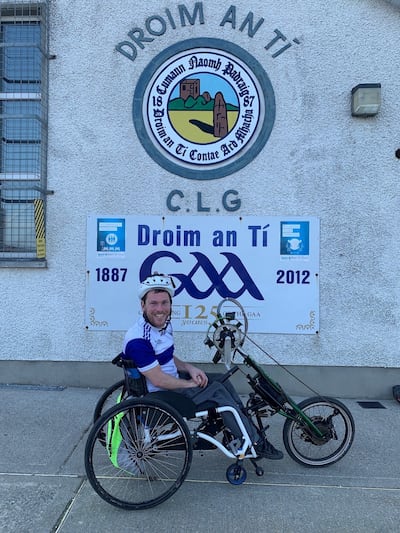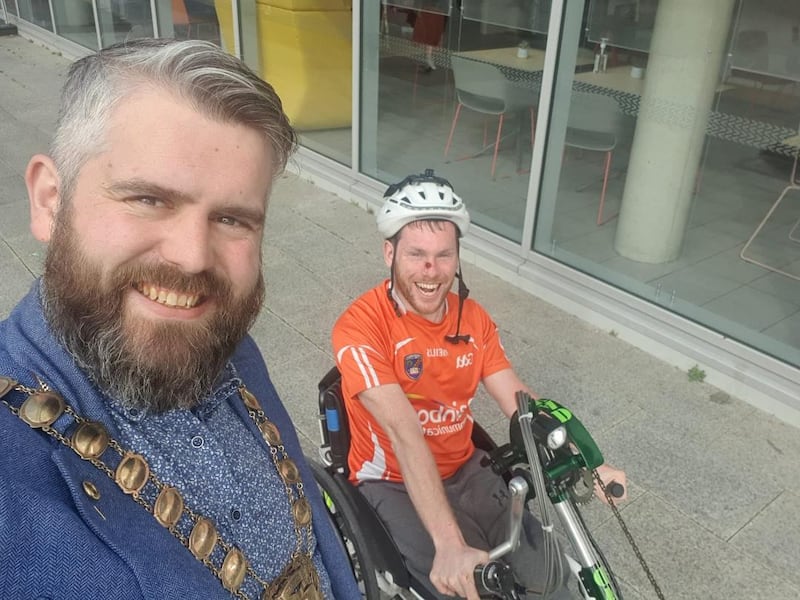This trip had been on-hold for two years, but it didn't disappoint. Last week, I had the good fortune to be able to embrace the glorious sunshine and spend many hours handcycling on the east coast of Ireland.
Way back in the beforetimes, I embarked on the cliff walk between Greystones and Bray in Co Wicklow on one of my regular visits to see friends and family in Ireland when I wasn't working in London. Disaster struck: we got 80 per cent of the way there only to gain sight of a massive flight of steps.
Then the battery on my wheelchair went flat.
Defeated, I thought there must be a better way of getting around than this. My friend suggested handcycling and the idea kept chipping away. A handcycle is essentially a wheel that attaches to the front of a wheelchair and is powered by turning two cranks. I gave it a try and really enjoyed the ability to go where I wanted at a faster pace.

During lockdown, I learned to handcycle with my dad on the roads of my town, Birkenhead near Liverpool. Having never even driven on the road before, it was a big deal for me. Over time, the journeys got longer and an idea started forming in my head: what if I took my handcycle with me to Ireland for a cycling trip?
Having had three vaccinations and a Covid infection by the start of 2022, I decided that I wanted to venture outside of my immediate area. Spurred on by Siobhán McSweeney's wonderful cycling tour of the north, I thought maybe such an adventure could become a reality for me. Environmentally conscious, I looked at flight-free routes and discovered that there was a ferry from my hometown to Belfast. I contacted friends and family members to see who'd be up for meetings. Pipe dreams turned into reality.
I took the overnight ferry to Belfast. Cycling in from the ferry (the first bit is a hair-raising dual carriageway, yikes!) I met up with friends I'd only ever spoken to on social media or Zoom, then spoke to a bunch of students at Queen's about accessible town planning, and cycled to Lisburn and back along the Lagan Towpath (it's gorgeous!). Later, venturing on to the Falls Road and into East Belfast with kids on both sides of the river cheering me on, the bus lanes made it easy to cycle around, even if the city was quite car-dominated.
The next bit for me was the real icing on the cake. When I told my family in South Armagh I was coming over, one of my uncles hatched a plan: we would cycle along the Portadown to Newry canal and then head to my grandma's townland of Adavoyle near Dromintee to see family there. The greenway ran through gorgeous, green, luscious countryside and the seeing my grandma's remaining octogenarian siblings was very special.
Councils and the Government can and should consult disabled people about how they experience getting around their communities
But the main victory was tackling the steep hills on the country roads outside my family’s farm in South Armagh and going to my cousin’s GAA club down the road (or, should I say, a rural pothole-filled incline).
Then it was time to head south to Dublin. I’ve always found it to be an easy city to navigate alone in my electric wheelchair (in comparison to London or Manchester, say). But I had no idea how I’d find cycling on its roads.
Happily it turned out to be quite enjoyable and accessible, despite my front wheel slipping into the Luas tracks several times and having to be rescued by random passers-by. I also encountered some narrow segregated cycle tracks which were inconsistent and difficult to pass on my handcycle (the area around College Green and Dame Street in particular).
Similar to Belfast, what I really enjoyed about Dublin was the significant number of bus lanes in the centre of the city allowing me to cycle unencumbered on my non-standard cycle and also permit faster “standard” cyclists to pass safely and quickly. There was also ample space to swerve any Ellis-swallowing craters – sorry, potholes – that threatened to throw me off-course. I did occasionally get lost in the one-way system though, especially in the north inner city.
The first day I took it (relatively) easy and headed to Dún Laoghaire to check out the fancy new coastal mobility route. I was very impressed, even though some bits were a little narrow on my slightly wider wheels. Afterwards, I headed back into town and climbed up Phoenix Park to Áras an Uachtaráin in the dusk. Alas, Miggledy and the doggos did not greet me, but I did see a deadly mural to them nearby.
On day two I ventured a little bit further to Tallaght to meet the Mayor of South Dublin County, Peter Kavanagh, a man with a cracking sense of humour who I had spent many hours listening to on the Motherfócloir podcast.

I found the painted-on cycle tracks on my route to Tallaght along Greenhills Road to be great, even though I’m quite a confident road cycler because my hometown doesn’t have much segregated infrastructure. There was ample space for cars to pass safely, and to avoid potholes.
Narrow widths on cycle tracks can make it difficult to use them safely on a non-standard cycle. You can become extremely self-conscious if you are holding other cyclists up in a segregated route. That embarrassment might just be internalised ableism, but it also might be enough to deter a self-conscious person from using a busy segregated route again.
The following day, the lovely people at South Dublin County Council invited me to join local cycle users and check out the new Dodder Valley Greenway. Although still not fully complete, it is a gorgeous route and its development has resulted in the removal of several restrictive kissing gates.
That said, I still got stuck in one of them at Oldbawn, Tallaght. I manoeuvred into the kissing gate but was unable to shut it behind me, and found myself stranded.
Now these things are often installed by local councils to allay residents’ concerns about scrambler bikes. But they can also make the route inhospitable to some of the most vulnerable populations.
As a disabled person who cannot dismount from my wheelchair independently to get through such obstacles, I don’t enjoy the luxury of cyclists who can just lift their bikes over the barrier. And it’s not just about me: it’s about other wheelchair users, older folks, scooter users, parents with prams and so on. Such restrictive barriers can put them off using otherwise accessible public infrastructure and from being engaged and included in their communities and public life.
If local-level walking, cycling, and retail infrastructure isn’t accessible, then people end up trapped and isolated from their communities or dependent on family, friends, or the kindness of strangers to do things many non-disabled people take for granted.

There are measures councils can take to improve routes for non-standard cyclists, by focusing on width and surface quality and consistency. All of these were excellent on the Dodder Valley greenway, but they just fell down when it came to the fundamental question of how people can get on and off in an accessible fashion. Perhaps CCTV cameras or appropriately-spaced bollards could be used to clamp down on antisocial behaviour more effectively?
Councils and the Government can and should consult disabled people about how they experience getting around their communities. The Disability Federation and Independent Living Movement Ireland have a great list of activists around the country who would be only too happy to advise based on their lived experiences.
It’s not necessarily about ripping out your infrastructure and rebuilding it from scratch, but thinking about how different groups of people with different perspectives might experience the same infrastructure.
All told, it was an incredible trip over the Irish Sea visiting friends and family and cycling along the east coast. For my next trip, I’m considering the Waterford Greenway, Cork, or maybe even Dublin to Galway. That is, if I don’t get trapped in a kissing gate first. Slán go fóill.











